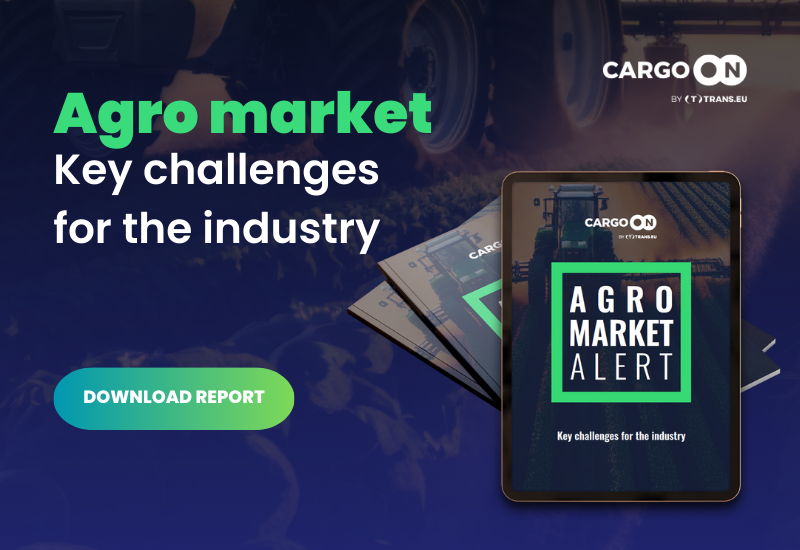Key challenges for the agro-industry
The agro sector is one of the largest and most important for the economy. The country’s food security and the availability of products in retail chains and on consumers’ tables depend on the smooth operation of supply chains. Meanwhile, the entire food production and distribution sector has been undergoing a real revolution for the last two to three years. Pandemic, war in Ukraine, drought on the continent, increase in energy prices, high inflation – all these factors accumulated in a short time have caused a very difficult situation in the agro industry. Without rapid automation of processes, however, the chaos will get even worse. What challenges do supply chains face in the upcoming months and quarters?
October 31, 2023

There are many challenges, and of course they differ by place in the supply chain and type of business. However, there is a common denominator that concerns the challenges for the entire sector. It is certainly the digitalization of the distribution network, which cannot succeed without data exchange between participants throughout the production and distribution process. But that’s not all.
Temperature and delivery times
– Prices and availability of raw materials, energy costs and the search for stable cooperation partners are just some of the challenges that companies from the agro industry face. Another challenge is the lack of predictability, in which we are constantly learning to operate over the past few years. We simply need to adapt to this reality. But we also remember the need to align with the principles of sustainable development and reduce our carbon footprint in production and transport – concludes Ilona Wzgarda, Director of the Organizational Division at De Heus Polska, an international company producing feed for cattle, poultry and pig breeders.
The temperature and delivery time of products play a key role in the food production sector. In particular, this applies to the distribution of vegetables, fruit and meat products, but not exclusively. The gigantic queues in front of the ports of Gdansk and other Polish ports, for example, highlight all the bottlenecks in the grain distribution. The time taken to load wheat or maize, which is then shipped to Germany, the Netherlands, Sweden, Great Britain and also to African countries, has an impact on the quality of the grain transported. – During long stops in ports, grain can become damp. This causes further complications in handling cargo and meeting contract terms – says Tomasz Okoński, head of logistics at Osadkowski sp.z oo. The company supplies growers with fertilizers and plant protection products, and deals with purchasing agricultural produce.
What can be done in such a case? Introduce, for example, delivery scheduling and a transport tracking service to efficiently facilitate the unloading process and minimize waiting times. Meanwhile, in Gdansk, you have to wait for unloading for up to 30 hours, which causes frustration among carriers who could take on new orders during this time. Moreover, truck queues are not limited to ports and grain silos, but can also be seen in front of food factories and processing plants where grain, vegetable oil and other agricultural products are delivered.
Automation is a must
The lack of automation of deliveries affects most companies operating in the agro sector. So, what’s the problem? As we mentioned earlier, systemic changes make the most sense when they apply to the entire supply chain. – We fully understand the need for delivery automation. We use our proprietary system to manage the transportation of agricultural products, thus reducing the reliance on Excel files and handwritten notes. However, it’s challenging to persuade many of our partners to adopt similar tools – comments Tomasz Okoński, logistics director at Osadkowski sp. z oo.
The problem lies more in mindset than implementation costs. For companies and carriers using transport platforms, the implementation of time slot management, delivery tracking or, for example, per-tonne settlement, is neither difficult nor expensive. The latter solution in particular is still little known in the agro sector. However, it should be better recognized because it brings significant simplifications to the process of ordering and settling the transport of bulk materials, such as grain, feed products, fertilizers as well as other agricultural raw materials and products.
Meanwhile, losses during transport of bulk products are the norm in the agri-food sector. Settlement for the actually transported load makes the entire process more transparent, easier to measure and more objective.
Our research shows that the distribution of bulk materials is settled differently than deliveries in other industries. Here, we have to deal with product losses and constant verification of quality. That is why we have created the option of settlement per tonne of transported goods on the platform, rather than per haulage. Everything is transparent and visible in the system. Starting with the obtaining a transport offer, the determination of the terms of the order, up to the actual execution of transport and settlement based on the reported load weight, adds Robert Kutera, Product Manager at CargoON, a supply chain expert.
Freshness is crucial
Automation of processes and the implementation of improvements across the entire chain are essential to ensure that products reach the producer (farmer, food industry company, etc.) as quickly as possible, and ultimately – the consumer’s table. And in the case of, for example, distribution of fresh fruit and vegetables, speed of transport is crucial to the success of the entire operation. – Providing food to big cities is still a huge challenge. High-quality fresh products are highly valued, but difficult to produce and transport over long distances – confirms Prof. Woody Maijers of Inholland University of Applied Science.
The Food, Beverage, and Agriculture Supply Chain Risk Report from March 2023 (by WTW) also emphasizes this point. The report summarizes threats to global food supply chains, but sees great opportunities to reduce potential crises in smart solutions. Technological solutions can also ensure higher product quality.
– Technology also has the potential to reduce the amount of spoiled products in the logistics chain – for example, by using telematics and the internet of things to track goods in transit and monitor their condition – adds Simon Lusher, WTW’s global food and beverage leader.
The Polish Fruit Union also highlights the importance of ensuring the freshness and durability of products. This is because Polish products enter the European Union market, but also increasingly reach Asian markets, Egypt, Jordan, the United Arab Emirates and Saudi Arabia. In warm countries, high temperatures become a challenge if exporters want to deliver fresh products to the end consumer. Access to refrigerated containers is no longer a problem, but exporters also need to ensure the quality of goods during distribution in the destination countries, such as Colombia and Costa Rica.
Investment, investment
Polish producers export mainly fruit and dairy products, and these are products that require the right temperature, especially during transport in warm countries. The sector is favored by lower transport costs, which is of considerable importance in view of rising production prices. Not only sea freight prices are falling, but also truck transport prices.
Deliveries on time and product availability throughout the year is becoming increasingly significant. Importers from African or Asian countries expect high quality fruit not only when they are loaded in Poland, but above all when they are traded in the destination country. And this costs money and requires additional investment in quality, confirms Paulina Kopeć, Secretary General of the Fruit Union Association.
However, the lower transport costs compared to a year ago are a transitional situation because as economic growth increases, the demand for transportation will quickly rise again, along with transportation costs. Once more, without technological tools, the agro sector could plunge into chaos. – We left the Excel era in logistics a long time ago, but it does not mean that the process of digitalization has ended for us. We are aware that there are still many areas for improvement. From the logistics point of view, we need to optimize our systems to keep up with the times – says Ilona Wzgarda from De Heus.

Challenges for supply chains in the agro sector
1. Implementing sustainability principles. Sooner or later, all actors in the supply chain will have to apply ESG principles in their daily practice. The obligation of non-financial reporting and carbon footprint measurement for large companies from 2024 will trigger a chain reaction. Contractors and suppliers who do not measure the carbon footprint of their operations (and reduce their emissions) will be excluded from the supply chain.
2. Storage of raw materials. Uncertainty of supply, particularly important in the production of feed, feed additives, raw materials and intermediates, creates a need for storage. Lack of available storage space can cause constraints on the supply of finished products. One solution is to shorten the supply chain by delivering finished products directly to the customer.
3. Production costs. In the face of increasing production costs, the challenge for companies in the agro sector is to maintain a competitive price. Rising energy prices, costs of raw materials and intermediates, distribution, as well as costs related to reducing greenhouse gas emissions inevitably lead to higher product prices. The consequences of drastic cost cutting can be very serious. Due to gas price spikes in the Netherlands, for example, the production of greenhouse tomatoes collapsed and Polish distributors often gave up drying grain.
4. Automation of supply chain management processes. Long queues at warehouses are the best indication of the level of digitalization of distribution networks. Efficient supply management is not possible without data exchange among participants in the food supply chain, without delivery scheduling and transport tracking systems, etc. Carriers are increasingly avoiding orders that expose them to long queues at ports, in front of silos and in warehouses of food companies.
5. Investment in RES. The direction set firmly by the European Union, i.e. achieving of climate neutrality and the use of alternative energy sources, is also determining changes in the agro sector. Some companies in this industry are already investing in photovoltaic power for the lighting of warehouses and yards. Investments in RES also reduce the costs associated with the purchase of electricity, which in turn contributes to lower operating costs. However, in order to save money, it is first necessary to invest.



